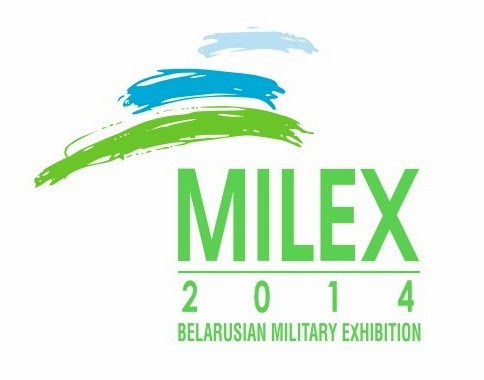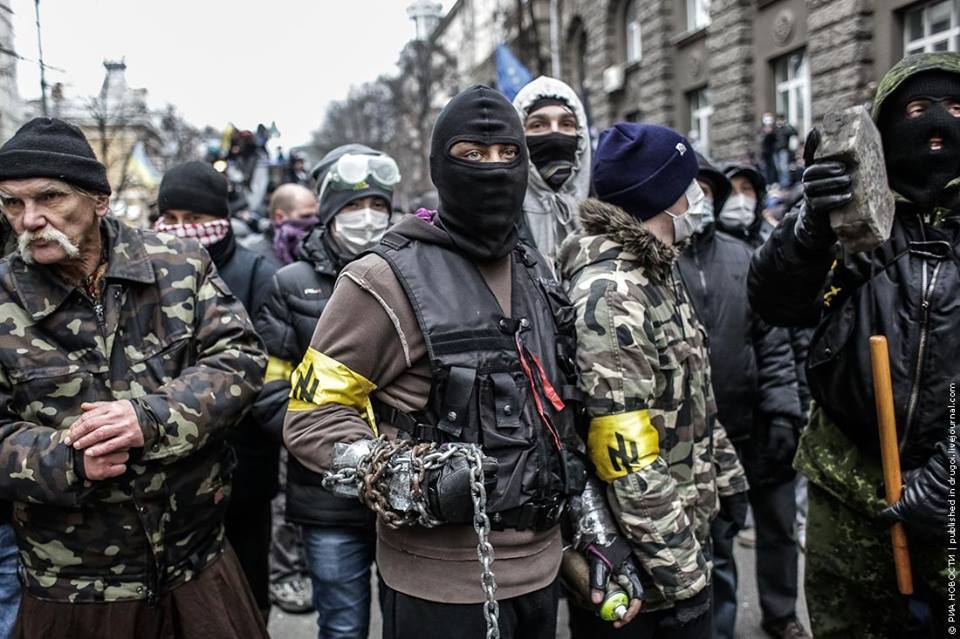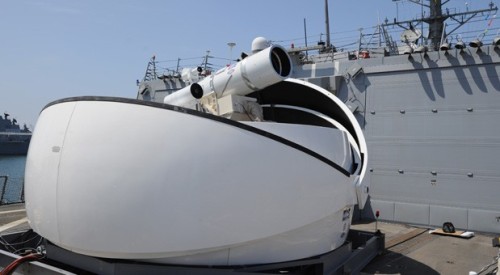In the last decades of the 20th Century, the proponents of Directed Energy Weapons (DEW) have promised that lasers and high-power energy weapons would revolutionise warfare. In many ways, this promise has come true in a different form as thousands of smaller lasers fill the arsenals of modern military forces. These lasers, however, are mostly range-finding systems designed to improve the capability and effectiveness of kinetic weapons or dazzlers designed to incapacitate enemy optics. Recent developments, however, suggest that the promise of DEW is moving closer to reality.
Lasers, phasers, blasters, and EMP weapons have been part of our lexicon as they are the iconic armaments of science fiction (SF), but the real-world issues of power, heat capacity, size, and the “inclination to use directed energy weapons against fellow humans,” has made these visions difficult to materialise. Today, DEW technologies are generally differentiated as high-energy lasers (HELs), high-power microwaves (HPMs), or charged-particle beams. The truth is that we are getting closer to the day when DEW systems will be widely deployed in the battlespace. This article reviews several promising RF and laser systems that are available today and considers the most likely trends for the military application of DEW systems in the next decade.
Active Denial System (ADS)
The Active Denial System (ADS) is a DEW system that is available, fielded and ready for combat. The ADS, sometimes referred to as a heat ray or pain ray, was created by Raytheon, a world-leader in microwave development and design, and is one of the first non-lethal, directed-energy, counter-personnel systems fielded to the US Army. The ADS was designed to be a non-lethal crowd control and area denial system. It is vehicle mounted and has been tested at a range of approximately one kilometre. ADS sends an extremely high frequency and focused beam of 95GHz waves at a person, or group of people, causing intense pain. The energy causes human skin surface temperature to rise and become so uncomfortable in a few seconds that people are compelled to leave the target area. Hundreds of human tests have been conducted and the ADS has been certified as non-lethal, but doubts remain concerning its long term health effects or what happens to a person under extended exposure. The ADS was deployed to Afghanistan in 2010, but was never used and was withdrawn by sceptical field commanders. The ADS was demonstrated by the US Marines at Quantico, VA in March 2012, and the system was enthusiastically embraced by the Marines. “
You’re not going to hear it, you’re not going to smell it, you’re going to feel it,” said
Col. Tracy Tafolla, Director of the Joint Non-lethal Weapons Directorate, “
and that provides us with some advantages we can use.”
High Energy Laser Mobile Demonstrator (HEL MD)
Boeing has been at the forefront of DEW development and has designed and tested a 10kW, solid-state laser system called the High Energy Laser Mobile Demonstrator (HEL MD) for the US Army. This is the closest thing to the “death ray” of SF as it is actually a very big laser cannon. The entire Hel MD system is housed aboard an Oshkosh Heavy Expanded Mobility Tactical Truck (HEMTT). The complete HEMMT mounted HEL MD system weighs about 17t, but it does something remarkable; it is one of the only mobile systems that can shoot down incoming mortar shells at laser light speed. The system includes the hardware to track incoming shells and, once the laser is locked-on, the high-power laser incinerates the target. Military planners envision the Hel MD defending priority facilities and bases where there will be an ample supply of energy to provide the HEL MD with an abundant supply of ammunition. “
The Boeing HEL MD programme is applying the best of solid-state laser technology to ensure the Army has speed-of-light capability to defend against rockets, artillery, mortars, and unmanned aerial threats -- both today and into the future," said
Mike Rinn, Vice President and Program Director for Boeing Directed Energy Systems. Boeing expects the system to be complete and ready for production by 2018 and will upgrade the laser from 10kW to 100-kilowatts.
YAL-1 Airborne Laser Testbed (formerly Airborne Laser)
The Boeing YAL-1 Airborne Laser Testbed, formerly Airborne Laser (ABL), weapons system is a megawatt-class chemical oxygen iodine laser (COIL) mounted inside a modified Boeing 747-400F. It is primarily designed as a missile defence system to destroy tactical ballistic missiles (TBM), while in boost phase. The US Missile Defense Agency (MDA) in August 2009 successfully fired the HEL aboard the aircraft in flight for the first time. In January 2010, the HEL was used in-flight, to intercept, although not destroy, a test Missile Alternative Range Target Instrument (MARTI) in the boost phase of flight. In February 2010, in a test off the central California coast, the system successfully destroyed a liquid-fuel boosting TBM. Less than an hour after that first missile had been destroyed, a second missile—a solid-fuel design—had, as announced by the MDA, been successfully engaged, but not destroyed, and that all test criteria had been met. The MDA announcement also noted that ABL had destroyed an identical solid-fuel missile in flight eight days earlier. This test was the first time that a directed-energy system destroyed a TBM in any phase of flight. It was later reported that the first February engagement required 50% less dwell time than expected to destroy the missile, the second engagement on the solid-fuel missile, less than an hour later, had to be cut short before it could be destroyed because of a “beam misalignment” problem. Funding for the programme was cut in 2010 and cancelled in December 2011. As of 2013 studies are underway to apply the lessons of the YAL-1 by mounting laser anti-missile defences on UCAVs that could fly above the altitude limits of the converted jetliner.
![]()
Area Defense Anti-Munitions (ADAM)
Lockheed Martin has also been a forerunner in the development of HEL weapon systems. For the past few hears Lockheed Martin has developed the Area Defense Anti-Munitions (ADAM) system to defend critical locations against short-range threats such as UAVs and improvised artillery rockets like the QASSAM rocket. ADAM’s laser and fire control system is contained in a large trailer that can be pulled by a truck. Once ADAM is in position and powered up, it can receive information from a network of nearby radars or, if properly cued, operate as a stand-alone system. After an alert is received, ADAM can track targets at a range of 5km and destroy them up to 2km away with its 10kW laser. According to Lockheed Martin, during demonstrations in 2012, the system acquired, tracked and destroyed the target within three seconds. In November 2012, Lockheed Martin reported that ADAM had successfully “
destroyed four rockets in simulated flight from a distance of 2km, and ‘engaged’ with a UAV from 1.5km, forcing it into a controlled crash.” In further testing in March and April 2013, ADAM destroyed eight incoming small-calibre QASSAM-like rockets. Lockheed Martin is continuing to improve ADAM and, according to Tory Bruno, President of Strategic and Missile Defense Systems, Lockheed Martin Space Systems, ADAM is “
a practical, affordable directed-energy solution to the real-world problem of close-in threats.”
Bofors High-Power Microwave (HPM) BLACKOUT
Some non-lethal DEW systems can be difficult to detect. This can provide a unique tactical advantage in modern conflict. Imagine if you could deny the opponent’s use of electronic devices at a flip of a switch? An example is the BAE Systems Bofors High-Power Microwave (HPM) BLACKOUT. This system is a mobile microwave source that can turn off unprotected electronic systems. Originally designed as an evaluation and research device, the Bofors HPM BLACKOUT could have operational capabilities. An information sheet on the system stated that the system “
has proven destructive effects at considerable distance against a broad field of COTS equipment… The system is composed of an integrated modulator, a microwave source and an antenna.” The system weighs less than 500kg and the about 2m long. An operational version of the Bofors HPM BLACKOUT could knock out key target areas, turning off many COTS and some military electronic systems, leaving the opponent unable to use mobile cell phones, smartphones, tablets, devices, and weapon systems. According to a recent BAE Systems report, a team of their researchers from Karlskoga, Sweden, “
demonstrated that the Bofors HPM BLACKOUT system had a destructive effect on selected electronic devices in weapons, showing that it could be a valuable complement to other weapons, particularly in an ‘asymmetric’ environment where real threats are mixed up with innocent civilians.” It is clear that DEW systems like the Bofors HPM BLACKOUT could be used to dominate the electromagnetic battlespace.
High-Power-Electro-Magnetics (HPEM)
Diehl has developed a series of microwave sources, based on multi-stage Marx generators and microwave oscillators (method of generating microwaves from DC pulses is unclear), ranging from man portable (operating at 375 MHz and DS110B operating at 100-300MHz range), and stationary unit (operating at 100MHz [in oil], 60MHz [in glycol] and 50MHz [in water]-all at maximum PRF of 50 Herz). The man portable systems reportedly generate 400kV and 700kV, while the stationary unit output can achieve 1MV. Diehl’s technical staff has been working on the development/implementation of a high-gain antenna to improve the efficiency of the above systems to be used in military applications.
In January 2013, the US Patent Office assigned a patent to Diehl BGT Defence for their Microwave Generator.
The use of nonlethal HPEM (High-Power-Electro-Magnetics) systems is a new capability enabling military and civil forces to eliminate command, information and monitoring systems. HPEM sources can be used for personal and convoy protection, for instance, to overload and permanently destroy radio-based fuzing systems. In contrast to conventional jammers, the HPEM convoy protection system is also effective against new types of sensor-based IEDs. Enemy vehicles with electronic motor management can be stopped inconspicuously by mobile and stationary HPEM systems (car stopping). Diehl Defence’s new HPEM technology protects convoys against IEDs, can stop getaway vehicles and prevent unauthorized access to limited access areas. Thus, this technology contributes decisively to the protection of soldiers in international missions.
HPEM can also support special and police forces in fulfilling their tasks. HPEM systems suppress enemy communication and disturb reconnaissance and information systems, for instance, in freeing hostages. Analyses dealing with the effect of high-energy electro-magnetic pulses on weapon systems lead to the concept of nonlethal effectors capable of neutralising hidden IEDs at a safe distance without harming human beings and the environment.
Portable HPEM units are available as test systems, as well as vehicle-integrated basic systems against IEDs and for car stopping. In the spring of 2011, HPEM prototypes for convoy protection (C-IED) were successfully tested on an armoured carrier platform in Afghanistan.
LaWs Ship-borne Laser
LaWs is a solid-state laser weapon system designed by Raytheon for close-in ship defence. This DEW system combines six HELs into a single beam to target slow-moving targets and is connected to a radar-controlled system that locates and tracks incoming targets. LaWs is expected to supplement conventional close defence kinetic weapons systems and can be directed onto targets from the radar track obtained from a MK 15 PHALANX Close-In Weapon system or other targeting sources. After successful operational testing in 2012, Captain David Kiel, the US Navy’s Program Manager for LaWs stated that “<I>the success of this effort validates the military utility of Directed Energy Weapons in a maritime environment. Further development and integration of increasingly more powerful laser in to LaWs will increase both the engagement range and target sets that can be successfully engaged and destroyed<P>.”
The US Navy considers LaWs to be a capable and accurate system that is low-risk and high-payoff. “
Our conservative data tells us a shot of directed energy costs under $1,”
Chief of Naval Research Rear Adm. Matthew Klunder said in an 8 April 2013 interview. “
Compare that to the hundreds of thousands of dollars it costs to fire a missile, and you can begin to see the merits of this capability.”
Citing a series of technological breakthroughs in the LaWs development programme, the US Navy announced that it would deploy the LaWs aboard the USS PONCE, an AUSTIN–class amphibious transport dock ship, in 2014.
Development of a High-Energy Laser Weapon-Based (V)SHORAD System
A laser weapon, or DEW, emits energy in an aimed direction without the means of a projectile. It transfers energy to a target for a desired effect. Intended effects on humans may be non-lethal or lethal. These effects have been categorised as physical, physiological and psychological. The energy can come in various forms, electromagnetic radiation, including radio frequency, microwave, lasers and masers; particles with mass, in particle-beam weapons (technically a form of micro-projectile weapon); and sound, in sonic weapons.
Laser Weapons are particularly suitable for operations requiring high precision, fast, scalable effects and for defence against low-cost targets in large numbers.
MBDA is advancing high power lasers in developing an integrated systems approach for laser weapon systems. Application advantages include, immediate effect on target; low optical detectability; low costs for logistics/maintenance and very low costs per operation; scalable effects on target / possibility to escalate, very precise, extremely selective; no collateral damage caused by ammunition; and no procurement, storage or transport of ammunition.
Potential applications for laser weapon systems include protection of high value assets, such as Forward Operating Bases and the such, soldiers and vehicles (air, ground, and maritime); the ability to enhance or inhibit tactical mobility; and for defence against terrorism. This by being able to do Counter-RAM, Counter-UAV, C-IED/IEDD, and Counter-MANPADS.
Today the focus of high power laser activities in MBDA is on an integrated systems approach for laser weapon systems. MBDA is working on a C-RAM Laser Weapon System. This work contracted by the European Defence Agency (EDA) and the Federal Office of Bundeswehr Equipment, Information Technology and In-Service Support (BAAINBw) is making excellent progress. To accelerate development, MBDA has invested a significant amount of its own money in the programme.
Using 40kW of laser power, the laser demonstrator successfully acted on airborne targets at a range of over 2,000m and an altitude of 1,000 metres. The necessary infrastructure is already in place at MBDA‘s Schrobenhausen site. This comprises: three test ranges for firing and tracking trials, a test laboratory as well as a roof laboratory with a laser demonstrator which together offer exceptional possibilities for current and future development work.
More development on this is currently being done by Rheinmetall, Rafael, Lockheed Martin, etc, just to name a few...more on this in the ILA Show Dailys.
The Next Ten Years
DEW systems are showing us what the future may look like. Before DEW can replace gunpowder and become a game-changing technology of war, the issues of power, heat, size and inclination must be overcome. “
A useful rule of thumb is that a stick of TNT contains about a megajoule (MJ) of chemical energy, and this amount is often needed to destroy a military target,” stated a June 2013 DEW report, Leading Edge, published by Naval Surface Warfare Center, Dahlgren Division. To become common battlefield weapons any future laser, phaser or blaster, will need to consistently produce close to 1MJ of destructive power. Most DEW systems are not there yet, but some systems may reach this capability as early as 2016.
At this moment, from what we can report from “open-source” information on DEW systems, the major promise of directed energy for military applications is in the ability to control crowds (ADS), turn-off non-shielded electronics (Bofors HPM BLACKOUT, HPEM), and protect critical areas and equipment (ADAM, LaWs and HEL MD). These capabilities alone provide an important battle capability that will impel continued R&D in DEW systems. For more lethal systems, power requirements will relegate DEW systems to large ships, large aircraft and as ground based point defence of locations with large power sources. Although the first lethal ground mobile laser system has already been deployed in a large vehicle, the Hel MD, it is not yet as mobile, versatile or lethal as current kinetic systems. In the next decade it may be possible to field a tank equipped with a newer version of a “Hel MD-like” laser system as significant technological hurdles are overcome. As Peter A. Morrison, a programme officer for the Office of Naval Research’s Sold-State Laser Technology Maturation Program reported on 8 April 2013, “
the future is here. The solid-state laser is a big step forward to revolutionising modern warfare with directed energy, just as gunpowder did in the era of knives and swords.”














.jpg)
.jpg)


























